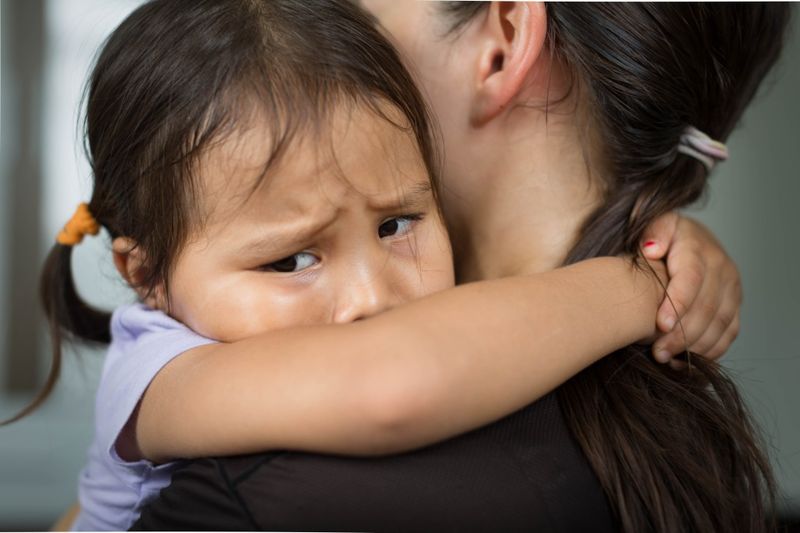20 Social Norms We Accepted As Kids That Seem Really Outrageous Now
Remember when some rules seemed etched in stone, only to crumble under the weight of modern thinking?
As kids, we absorbed societal norms like sponges, unaware that many were less about nurturing and more about maintaining the status quo. Now, with hindsight, these ‘norms’ feel more like quirky relics than pillars of wisdom.
Let’s explore 20 of these childhood rules that prompt us to chuckle—or cringe—a little today.
1. Being told to hug relatives—even when it felt wrong

Family gatherings often came with a set of unwritten rules, one of the most prominent being the obligatory hug. Picture this: a small child, feeling the awkwardness of unfamiliar arms and faces, yet urged to embrace adults they barely knew. The pressure to comply often overrode personal comfort.
Back then, saying ‘no’ wasn’t an option; not hugging was seen as rude. Fast forward to today, and the emphasis lies on teaching consent and boundaries. Parents are increasingly aware of their children’s comfort levels, prioritizing personal space above outdated courtesies.
While the intention was perhaps to foster familial bonds, the execution was flawed. The lesson learned? Respect is mutual, and comfort shouldn’t be compromised. The shift towards understanding bodily autonomy is a testament to evolving social norms that prioritize a child’s voice and choice.
2. Getting in trouble for “talking back” when we were just asking questions

Curiosity is a natural part of childhood—a trait often mistaken for impudence in past educational settings. Remember being scolded for “talking back” when you simply wanted to understand more? Many kids learned early on that questioning authority could lead to trouble rather than enlightenment.
This mindset stifled intellectual growth, equating obedience with good behavior. However, modern education encourages inquiry, recognizing that questions foster learning and critical thinking.
Today, the classroom is a forum for dialogue, not just lectures. Teachers are urged to nurture curiosity, understanding that every question is a step towards broader horizons. The shift from silence to dialogue empowers children to think independently, transforming the “talking back” label into a compliment rather than criticism.
3. Having to finish your plate no matter how full you were

Ah, the clean plate club—a membership most of us never signed up for willingly. The mantra of finishing every last bite was less about hunger and more about ingrained habits. Many grew up believing that leaving food was wasteful, often at the expense of listening to their own bodies.
This norm ignored individual satiety cues, teaching children to override natural hunger signals. Today, there’s a growing focus on mindful eating, promoting healthy relationships with food rather than rigid rules.
Encouraging children to eat until satisfied, rather than stuffed, fosters body awareness and prevents unhealthy eating patterns. The emphasis has shifted from quantity to quality, recognizing that nourishment is more than just what’s on the plate.
4. Being praised for never crying

Tears, the natural expression of emotion, were once seen as something to be controlled, if not suppressed altogether. “Big boys don’t cry,” or that stoic demeanor was celebrated, creating a culture where emotional expression was equated with weakness.
This mindset particularly affected boys, discouraging them from developing emotional intelligence. Fast forward, and mental health awareness champions the importance of expressing feelings as part of a healthy emotional life.
Today, parents and educators emphasize emotional literacy, encouraging children to articulate feelings openly. Celebrating emotional expression fosters resilience and empathy, transforming tears from signals of weakness into symbols of strength and authenticity.
5. Being taught to respect adults—no matter how they treated you

Respect was once a one-way street, flowing strictly from child to adult, irrespective of how respect-worthy the adult’s behavior might have been. Children were taught to obey, to listen, and most importantly, never to question an adult’s authority.
This dynamic often left children vulnerable, unable to discern when to stand up for themselves. Today, respect is understood as reciprocal, earned through actions and mutual understanding.
Teaching children to respect others, while also demanding respect in return, empowers them to navigate relationships healthily. This balance ensures children grow up confident in their ability to assert themselves, making respect a shared value rather than an imposed condition.
6. Teachers telling you to “just ignore the bullies”

The advice to “just ignore them” might have been well-intentioned, but it left many children feeling isolated and powerless against bullies. This approach suggested that enduring mistreatment was preferable to confronting it, inadvertently allowing bullying to persist unchecked.
Today, anti-bullying initiatives focus on accountability and support, creating environments where children feel safe and heard. Schools are encouraged to implement programs that empower students to speak up and seek help.
The shift from silence to action fosters a culture where bullying is addressed proactively, promoting kindness and inclusion. Children learn that standing up for oneself and others is a strength, not a weakness, transforming bystander apathy into collective responsibility.
7. Girls being told they were “too bossy” for having opinions

Leadership skills in girls were often mislabeled as “bossiness,” a term that suggested assertiveness was unfeminine. Girls learned to temper their voices and shrink their presence to be considered agreeable, planting seeds of self-doubt.
Today, the narrative is shifting towards celebrating female leadership, encouraging girls to express their opinions confidently. Society is beginning to value assertive women and recognize that bossy is just another word for leadership.
Programs that empower young girls to lead instill confidence and ambition, transforming past criticisms into commendations. By redefining what it means to lead, we encourage future generations of women to embrace their strengths unapologetically.
8. Boys being told not to cry or “act like a girl”

The stereotype of emotional stoicism in boys dictated that any sign of vulnerability was “girly” and undesirable. Young boys were taught to suppress emotions, associating masculinity with emotional detachment.
This harmful norm not only stifled emotional growth but reinforced toxic masculinity. Modern perspectives encourage boys to embrace their emotions, recognizing tears as a healthy outlet rather than a sign of weakness.
Teaching boys to express feelings openly fosters emotional intelligence and mental well-being. By breaking down these outdated barriers, we cultivate a generation that values empathy and openness, redefining strength as the ability to feel deeply and authentically.
9. Being punished for being “too sensitive”

Sensitivity, once mistaken for fragility, was often met with frustration or punishment. Children labeled as “too sensitive” were frequently misunderstood, their emotional depth seen as a liability rather than a strength.
In reality, sensitivity is a gift, offering unique insights and empathy. Today, there’s a growing respect for emotional diversity, recognizing that sensitivity is a vital component of human connection.
Parents and educators are encouraged to nurture sensitive children, helping them harness their emotional awareness as a strength. This shift promotes a culture that values emotional openness, transforming sensitivity from a weakness into a celebrated trait.
10. Being made to apologize just to move on—even when we weren’t wrong

The forced apology—an exercise in diplomacy that prioritized peace over truth. Many children were taught to say “sorry” as a quick fix, regardless of fault. This approach valued harmony over honesty, leaving children confused about the true meaning of apology.
Today, teaching genuine accountability is prioritized, emphasizing understanding and sincerity over rote repetition. Apologies are encouraged to be thoughtful, reflecting true remorse and empathy.
By fostering authentic communication, we teach children that resolving conflicts is about more than just words. It’s about understanding different perspectives and taking responsibility when necessary, nurturing a culture of integrity and compassion.
11. Wearing what adults picked out—even if it made us uncomfortable

Personal style was often a luxury not afforded to children, who wore what was chosen for them, comfort be damned. Many recall squirming in itchy clothes at family functions, their own preferences overlooked in favor of adult approval.
Today, there’s a greater appreciation for children’s autonomy and expression, recognizing that style is a form of self-expression that deserves respect. Encouraging children to choose their outfits fosters self-confidence and individuality.
This shift empowers children to explore their identities through fashion, turning a daily necessity into a creative outlet. Recognizing the importance of choice, we celebrate youth for their unique tastes, moving beyond outdated sartorial mandates.
12. Having zero privacy and being told “You don’t pay bills”

The concept of privacy was often dismissed with the reminder that children don’t pay bills. Personal space was a privilege, not a right, leading to feelings of vulnerability and frustration. Many grew up under constant supervision, with little room for personal boundaries.
Today, there’s a growing understanding of the importance of privacy for healthy development. Children are taught the value of boundaries, learning to respect and demand them as part of their growth.
By recognizing privacy as a fundamental right, we foster environments where trust is mutual. This shift encourages healthy parent-child relationships, where space is respected and autonomy is nurtured.
13. Being forced to participate in class presentations even with anxiety

Public speaking, a common source of anxiety, was once seen as a non-negotiable skill. Children were expected to present in front of classmates, their discomfort often mistaken for defiance. The “sink or swim” approach overlooked the nuances of individual confidence levels.
Today, educators recognize the importance of accommodating different learning styles, offering alternatives to traditional presentations. This understanding fosters a supportive environment where students can thrive without fear.
By acknowledging anxiety as a legitimate concern, we create classrooms that embrace diversity in expression. Children learn that courage isn’t about fearlessness but about finding strength in vulnerability, transforming anxiety into empowerment.
14. Girls being warned not to “distract boys” with their clothing

The notion that girls’ clothing could be a distraction placed undue responsibility on them, reinforcing outdated gender norms. Girls were taught to be mindful of how their appearance affected boys, an unfair burden that policed their bodies and choices.
Today, there’s a push towards gender equality, recognizing that attire is a personal choice, not a tool for control. Educators and parents strive to dismantle these norms, promoting respect and equality.
By shifting focus from policing to empowerment, we encourage girls to dress for themselves, fostering self-confidence and autonomy. The emphasis is on mutual respect, teaching that distraction is a personal responsibility, not an imposed label.
15. Being told to “grow up” the second we expressed emotions

Emotional expression was often discouraged with a curt “grow up,” urging children to stifle their feelings for the sake of maturity. This mindset equated emotional suppression with adulthood, ignoring the importance of healthy emotional development.
Today, there’s a growing emphasis on emotional literacy, teaching children to understand and articulate their feelings. Recognizing emotions as natural and necessary fosters resilience and empathy.
Encouraging children to express themselves openly transforms emotional maturity into a journey, not a destination. This cultural shift supports a generation that values authenticity and emotional intelligence over stoicism, redefining what it truly means to grow up.
16. Being told you could be anything—but not being supported when you tried

The promise of endless possibilities often clashed with the reality of limited support. While children were encouraged to dream big, pursuing those dreams wasn’t always met with enthusiasm or resources. This disconnect between words and actions left many feeling discouraged.
Today, there’s a focus on providing tangible support, recognizing that nurturing a child’s potential requires more than just words. Encouraging exploration and providing resources helps children pursue their passions confidently.
By aligning encouragement with action, we foster environments where dreams are nurtured and ambitions are realized. This cultural evolution emphasizes mentorship and support, ensuring that children believe in their potential and feel equipped to pursue it.
17. Silence during dinner being seen as respectful

The rule of silence at the dinner table was seen as a sign of respect, often stifling children’s voices. Conversation was an adult privilege, leaving kids to observe quietly rather than participate. This norm minimized the importance of family dialogue and communication.
Modern families recognize the dinner table as a place for shared conversation and connection. Encouraging children to contribute to discussions fosters communication skills and strengthens family bonds.
By making mealtime inclusive, we create environments where everyone’s voice is valued. This shift turns dinner into a dynamic exchange, promoting active listening and mutual respect, transforming silence into lively dialogue.
18. Being expected to “earn” love with obedience

Love was often conditional, tied to obedience and compliance. Children learned that being “good” earned affection, creating a transactional dynamic that equated worth with behavior. This mindset overlooked the importance of unconditional love and acceptance.
Today, there’s a growing understanding that love is a constant, not a reward. Parents are encouraged to show affection regardless of behavior, nurturing self-worth and security.
By fostering unconditional love, we teach children that they are valued for who they are, not just what they do. This cultural shift emphasizes acceptance and understanding, transforming relationships and promoting emotional well-being.
19. Classroom Pledge of Allegiance

Every morning, like clockwork, students were led to recite the Pledge of Allegiance. This daily ritual was ingrained in our school routine. Yet, upon reflection, its patriotic fervor seemed forced upon young minds.
For children, understanding national loyalty was secondary to the act of conformity. The words were memorized, not critically thought about.
Did we comprehend the gravity of allegiance, or was it just a sequence of sounds? This tradition, once a staple, now prompts discussions about autonomy and freedom of thought in education.
20. The Myth of the Clean Plate

“Finish your food, or no dessert!” A familiar parental refrain, urging kids to clear their plates. But was this about nutrition or merely habit?
The clean plate club emphasized quantity over quality, ignoring the child’s hunger cues. Many grew up associating fullness with discomfort—a legacy of this dated norm.
Today’s dialogue shifts towards mindful eating and recognizing internal signals. A simple rule has evolved into a conversation about health and well-being, challenging the mindset that consumption equals appreciation.







